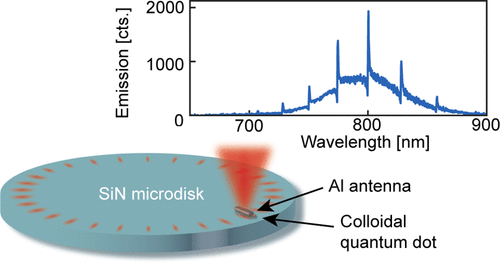Our official English website, www.x-mol.net, welcomes your
feedback! (Note: you will need to create a separate account there.)
Observation of Cooperative Purcell Enhancements in Antenna-Cavity Hybrids.
ACS Nano ( IF 15.8 ) Pub Date : 2020-09-01 , DOI: 10.1021/acsnano.0c05233 Hugo M Doeleman 1, 2 , Christian D Dieleman 1 , Christiaan Mennes 1 , Bruno Ehrler 1 , A Femius Koenderink 1, 2
ACS Nano ( IF 15.8 ) Pub Date : 2020-09-01 , DOI: 10.1021/acsnano.0c05233 Hugo M Doeleman 1, 2 , Christian D Dieleman 1 , Christiaan Mennes 1 , Bruno Ehrler 1 , A Femius Koenderink 1, 2
Affiliation

|
Localizing light to nanoscale volumes through nanoscale resonators that are low loss and precisely tailored in spectrum to properties of matter is crucial for classical and quantum light sources, cavity QED, molecular spectroscopy, and many other applications. To date, two opposite strategies have been identified: to use either plasmonics with deep subwavelength confinement yet high loss and very poor spectral control or instead microcavities with exquisite quality factors yet poor confinement. In this work we realize hybrid plasmonic–photonic resonators that enhance the emission of single quantum dots, profiting from both plasmonic confinement and microcavity quality factors. Our experiments directly demonstrate how cavity and antenna jointly realize large cooperative Purcell enhancements through interferences. These can be controlled to engineer arbitrary Fano lineshapes in the local density of optical states.
中文翻译:

天线腔混合动力中协同赛尔细胞增强的观察。
通过低损耗的纳米级谐振器将光定位到纳米级体积,该谐振器在光谱上根据物质的性质进行了精确调整,这对于经典和量子光源,腔体QED,分子光谱学和许多其他应用至关重要。迄今为止,已经确定了两种相反的策略:要么使用具有深亚波长限制,损耗高,光谱控制非常差的等离子激元,要么使用具有优良品质因数但封闭性差的微腔。在这项工作中,我们实现了混合等离子体激元-光子共振器,可增强单量子点的发射,并受益于等离子体限制和微腔质量因数。我们的实验直接证明了腔体和天线如何通过干扰共同实现大型赛尔塞尔增强合作。
更新日期:2020-09-22
中文翻译:

天线腔混合动力中协同赛尔细胞增强的观察。
通过低损耗的纳米级谐振器将光定位到纳米级体积,该谐振器在光谱上根据物质的性质进行了精确调整,这对于经典和量子光源,腔体QED,分子光谱学和许多其他应用至关重要。迄今为止,已经确定了两种相反的策略:要么使用具有深亚波长限制,损耗高,光谱控制非常差的等离子激元,要么使用具有优良品质因数但封闭性差的微腔。在这项工作中,我们实现了混合等离子体激元-光子共振器,可增强单量子点的发射,并受益于等离子体限制和微腔质量因数。我们的实验直接证明了腔体和天线如何通过干扰共同实现大型赛尔塞尔增强合作。









































 京公网安备 11010802027423号
京公网安备 11010802027423号